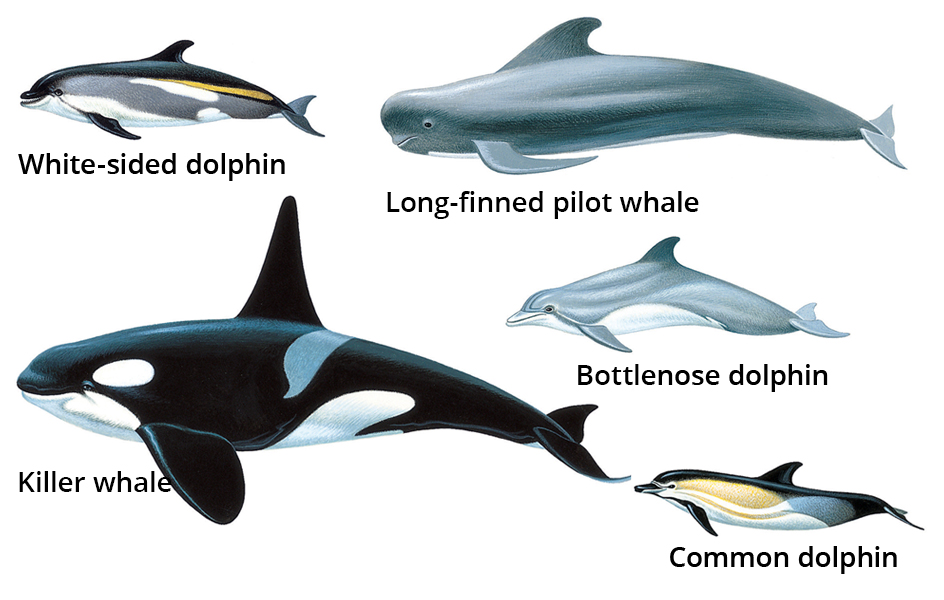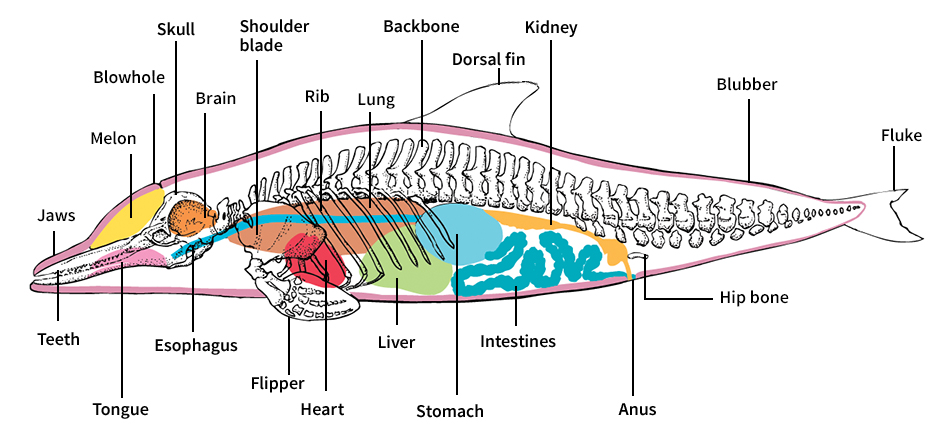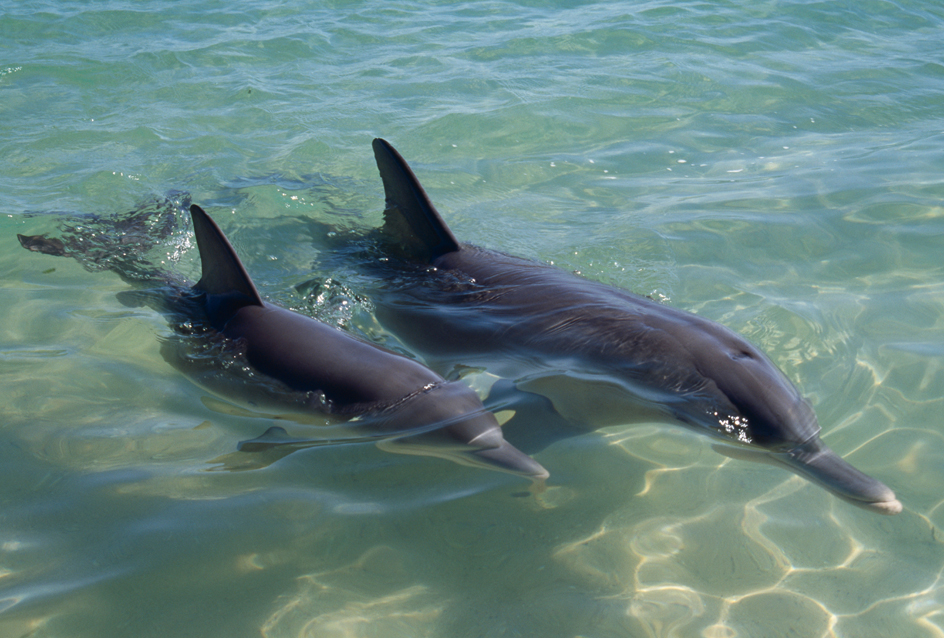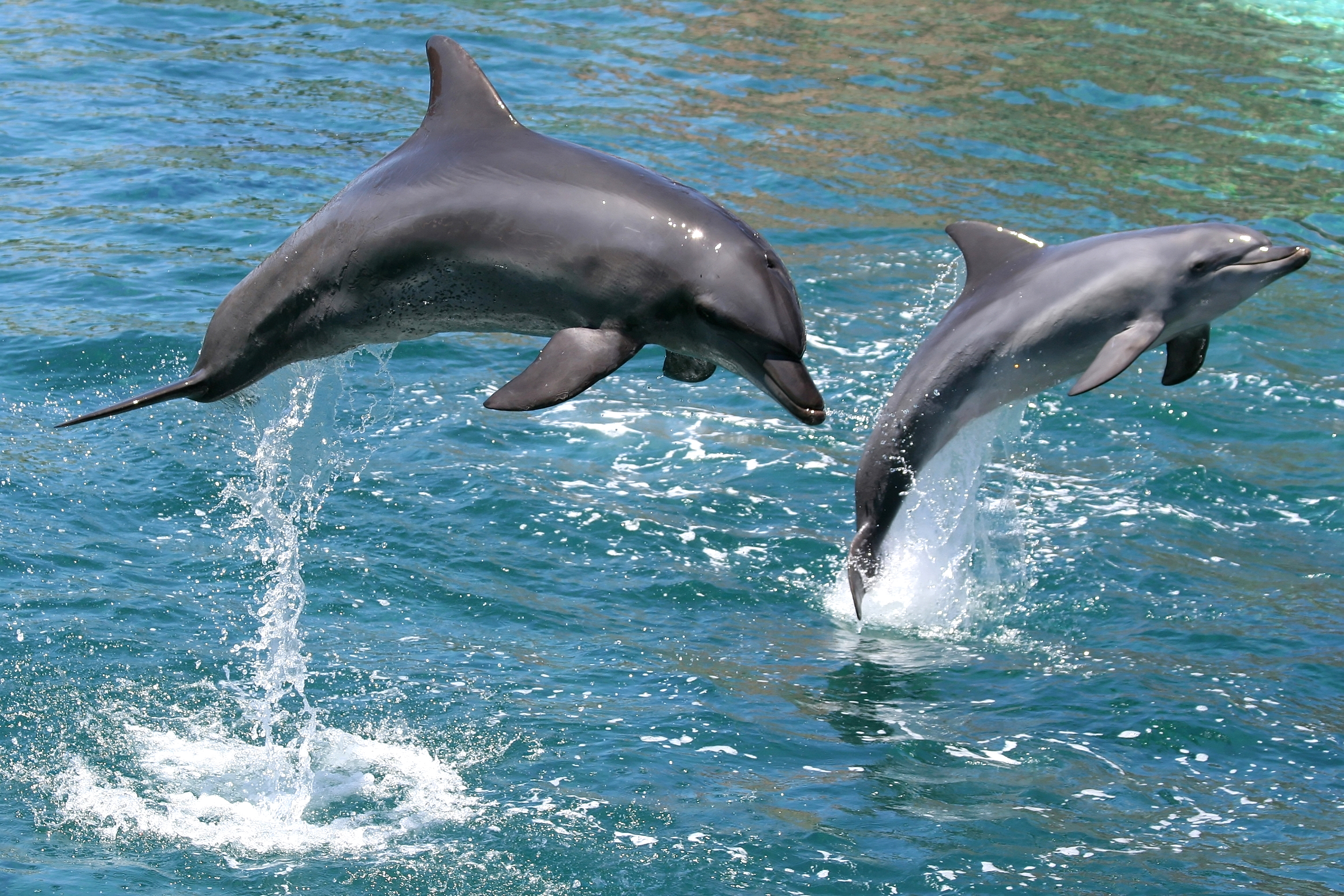Dolphin, << DOL fuhn, >> is the name of a group of sea animals closely related to whales and porpoises. Like whales and porpoises, dolphins are mammals, not fish. Mammals, unlike fish, feed their young with milk that is produced in the mother’s body. Also unlike fish, dolphins have lungs and are warm-blooded—that is, their core body temperature always stays about the same, regardless of the temperature of their surroundings. Many people believe that dolphins rank among the most intelligent animals, along with chimpanzees and dogs.
Loading the player...Dolphins
Dolphins, porpoises, and whales belong to a group of mammals called cetaceans << sih TAY shuhnz >>. Dolphins and porpoises closely resemble each other, and people often confuse the two groups. Their chief differences occur in the snout and teeth. Dolphins have a beaklike snout and cone-shaped teeth. Porpoises have a rounded snout and flat or spade-shaped teeth. Whales grow much larger than most dolphins and porpoises.
Scientists apply the term dolphin to two groups of cetaceans, marine dolphins and river dolphins. Marine dolphins live in nearly all oceans, and most of them inhabit only salt water. Some species (kinds) of marine dolphins remain near land for most of their lives, but many live in the open sea. River dolphins live in fresh or slightly salty water. This article focuses on marine dolphins. For information about river dolphins, see River dolphin.
Loading the player...Dolphins swimming
Types of dolphins
Dolphins usually range from 4 to 32 feet (1.2 to 9.8 meters) long and weigh from 100 pounds (45 kilograms) to 10 tons (9 metric tons). The most familiar types are the bottlenose dolphin and the common dolphins.

The bottlenose dolphin
is the best-known species. Its short beak gives this dolphin an expression that looks like a smile. Most dolphins in aquariums and zoos are bottlenose dolphins. Members of this species measure up to 13 feet (4 meters) long and can weigh as much as 600 pounds (272 kilograms). They are gray, but their backs are darker than their undersides. Some bottlenose dolphins show apparent great friendliness toward people, and they often swim alongside ships. They also adapt well to life in captivity.
Loading the player...Bottlenose dolphin
Bottlenose dolphins typically live in warm to tropical waters. Most of them stay within 100 miles (160 kilometers) of land. Many inhabit bays and protected inlets, where the water is relatively shallow. Bottlenose dolphins are found year around off the coast of Florida. They range as far north as Japan and Norway and as far south as Argentina, New Zealand, and South Africa.
The common dolphins
consist of two species with several distinct features. For example, a dark band around the eyes extends to the end of the narrow beak. Common dolphins also have black backs, white undersides, and prominent gray and yellowish-brown stripes on their sides. These animals grow from 6 to 8 feet (1.8 to 2.4 meters) long and weigh up to 165 pounds (75 kilograms). The most widespread species, the short-beaked common dolphin, has a shorter snout than the other species, the long-beaked common dolphin.
Loading the player...Common dolphin
Common dolphins live in temperate to tropical waters. They often swim in large schools and are frequently seen in the open ocean. Common dolphins sometimes follow ships for many miles. As they do so, these playful dolphins may leap out of the water and turn somersaults.
Other species
include killer whales, which are the largest dolphins. Killer whales can reach a length of 32 feet (9.8 meters) and may weigh up to 11 tons (10 metric tons). The two species of pilot whales, also called blackfish, grow 15 to 20 feet (4.6 to 6 meters) long. Pilot whales have gray to black backs and sides. These dolphins differ from other large dolphins because of their bulging foreheads. Among the most numerous species of dolphins are spinner dolphins, which often spin on their sides when they leap out of the water.
Loading the player...Killer whale
Many kinds of dolphins have distinguishing colors or other markings. For example, Risso’s dolphins are brown and gray, and most of them have many irregular white scratches on their bodies, made with the teeth of other Risso’s dolphins. White-sided dolphins have gray, white, and yellow stripes on their sides. Atlantic spotted dolphins are named for their white spots. The striped dolphin has black stripes on its sides.
The bodies of dolphins
All dolphins have streamlined, torpedo-shaped bodies, which enable the animals to move through the water quickly and easily. They have a pair of wing-shaped forelimbs called flippers, but no hindlimbs. Most species of dolphins also possess a dorsal fin on their back. This fin, along with the flippers, helps balance the animal when it swims. Powerful tail fins called flukes propel dolphins through the water.

The skin of dolphins is smooth and rubbery. A layer of fat, called blubber, lies beneath the skin. The blubber keeps dolphins warm and acts as a storage place for energy. It is lighter than water, and so it probably also helps dolphins stay afloat.
Like all other mammals, dolphins have lungs. The animals must surface regularly to breathe air and usually do so once or twice a minute. A dolphin breathes through a blowhole, a nostril on top of its head. The animal seals its blowhole by means of powerful muscles most of the time while underwater.
Dolphins have a highly developed sense of hearing. They can hear a wide range of low- and high-pitched sounds, including many that are beyond human hearing. Dolphins also have good vision, and the entire surface of their bodies has a keen sense of touch. All these senses function well both above and below the surface of the water. Dolphins have no sense of smell.
Dolphins navigate using a system called echolocation, which helps them locate underwater objects in their path. A dolphin locates such objects by making a series of clicking sounds. These sounds leave the animal’s body through the melon, an organ on top of the head. The melon consists of special fatty tissue that directs the sounds forward. Echoes are produced when the sounds reflect from an object in front of the dolphin. By listening to the echoes, the animal determines the location of the object.
Loading the player...Bottlenose dolphin
Most kinds of dolphins have a large number of teeth. Some species possess more than 200. Dolphins use their teeth only to grasp their prey, which are chiefly fish and squid. Dolphins swallow their food whole and usually eat the prey headfirst.
The life of dolphins
Most dolphins mate in spring and early summer. The males are called bulls, and the females are called cows. The pregnancy period for most species of dolphins lasts from 10 to 12 months. The females almost always give birth to one baby, called a calf, at a time. After the calf is born, it immediately swims to the surface for its first breath of air. A newborn dolphin is about a third as long as its mother.

Female dolphins, like all female mammals, have special glands that produce milk. The calf sucks the milk from its mother’s nipples. The females nurse and protect their young for more than a year. Male dolphins take no part in caring for the young.

Scientists do not know how long most species of dolphins live in the wild. The average lifespan may be about 20 years. However, some female bottlenose dolphins may reach 50 years of age, and some female killer whales may live as long as 90 years. Sharks probably rank as the chief predators of dolphins.
Dolphins often strand themselves on beaches, usually after suffering illness or injury. The animals cannot live long out of water because their bodies become overheated. In some cases, large numbers of healthy dolphins wash up together on shores. Scientists do not know why these mass strandings occur, but they may be due to changes in ocean current systems.
Social life.
Scientists learn about the social habits of dolphins by studying individuals in aquariums and zoos, as well as by studying animals in the wild. Killer whales live in the closest-knit groups. These groups, known as pods, mostly consist of from several to 17 or 18 animals. Each pod forms a family group dominated by an adult female. Bottlenose dolphins live in groups of up to about 12 individuals and have a less organized social structure. Among some dolphin species, the groups form herds of 100 to 1,000 dolphins.
Dolphins interact with one another in many ways. They may communicate using a complex series of whistles and clicks called phonations. The animals make these sounds in air-filled sacs connected to their blowholes. Dolphins also communicate by slapping their flukes on the water surface. People have even observed dolphins helping other dolphins that are sick or injured.
Swimming and diving.
Dolphins swim by moving their flukes up and down. This action differs from that of most fish, which propel themselves through the water by swinging their tail fins from side to side. Dolphins use their flippers to make sharp turns and sudden stops. Killer whales and some smaller species of dolphins can swim at speeds of 20 to 25 miles (32 to 40 kilometers) per hour. But they can maintain those speeds for only a short time. Most dolphins swim much slower.
Most dolphins do not usually dive deeply, though they have the ability to do so. Some dolphins have been trained to dive more than 1,000 feet (300 meters). When a dolphin dives, its lungs collapse and its heart rate slows down. These actions allow the animal’s body to adjust to the increasing pressure as the dolphin dives deeper underwater.
Dolphins and people
The attraction between dolphins and people goes back thousands of years. Ancient Greek artists decorated coins, pottery, and walls with pictures of dolphins, and the animals appear in Greek and Roman mythology. The ancient Greeks considered the common dolphin sacred to the god Apollo. For centuries, sailors have regarded the presence of dolphins near ships as a sign of a smooth voyage.
Dolphin conservation.
Human activities have greatly reduced dolphin populations. People have long hunted them for food and for the oil from their bodies, which is used as a lubricant. In addition, millions of dolphins have drowned in fishing nets that were intended to catch such sea life as mackerel, salmon, squid, and yellowfin tuna. Tuna fishing crews have been responsible for the largest number of these deaths among dolphins. For unknown reasons, some species of dolphins often swim over large schools of yellowfin tuna. As a result, nets meant to catch tuna trap many dolphins as well. In the late 1900’s, various governments passed laws limiting the number of dolphins that could be killed yearly by tuna fishing crews. Improved fishing technology also greatly reduced the number of dolphins killed unintentionally by human beings. In 1990, leading U.S. tuna-canning companies announced that they would refuse to accept tuna caught in nets that also kill dolphins. In addition, many countries have banned altogether the use of some of these nets.
Dolphin training and research.
Since the mid-1900’s, dolphins have been trained to perform in shows presented by aquariums, zoos, and theme parks. Most trained dolphins are bottlenose dolphins, though pilot whales, spotted dolphins, and killer whales have also performed in shows. These playful animals sometimes invent new behavior patterns by watching other dolphins perform. Some trained dolphins can leap 15 to 20 feet (4.6 to 6 meters) out of the water to ring a bell or touch a target. Many of the behaviors seen in these trained animals resemble behaviors of wild dolphins. Training a dolphin may take several years.
Scientists often use trained dolphins to study aspects of dolphin biology that they cannot accomplish using animals in the wild. Some of these studies focus on dolphin nutrition and health. Others focus on how the animals see, swim, dive, reproduce, or communicate. To conduct their studies, scientists need dolphins that will dive, hold still, and perform other tasks on command. Wild dolphins do not make good subjects for such research.
